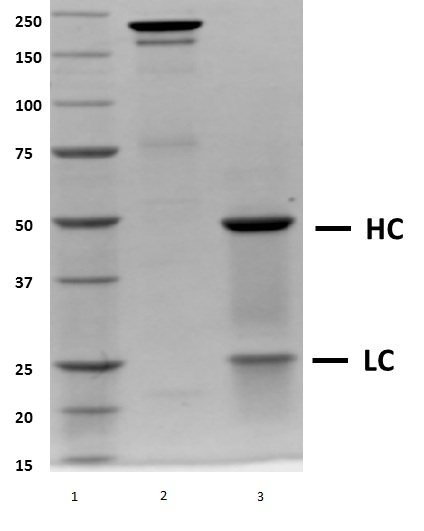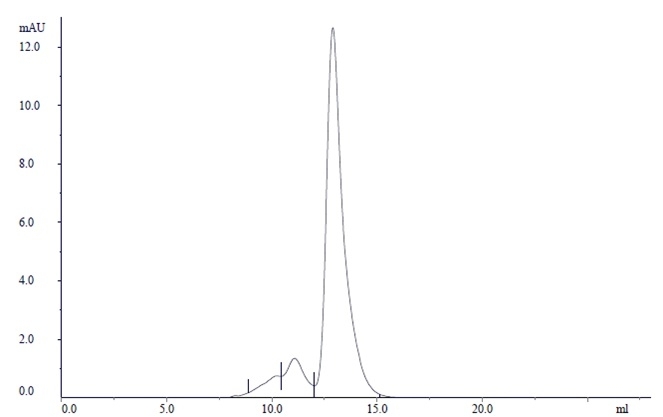Human IgG4 | AbD18705_hIgG4_Pro


Recombinant Human IgG4 Kappa (Mutant)
- Product Type
- Recombinant Protein
- Clone
- AbD18705_hIgG4_Pro
- Isotype
- IgG4 Kappa
- Specificity
- Human IgG4
- Region
- KAPPA
| Recombinant Human IgG4 kappa (mutant), clone AbD18705_hIgG4_Pro is a recombinant human IgG4 antibody with a kappa light chain and a mutation S228P in the core hinge region. Clone AbD18705_hIgG4_Pro is specific for green fluorescent protein (GFP) and has no known reactivity with mammalian proteins or other antigens. This product is recommended for use as a standard in assays designed to measure IgG4 levels, or as a control antibody when using other human antibodies of the same isotype and subclass. In addition to the tetrameric IgG structure, composed of two copies each of the heavy and light chains, wild type human IgG4 forms so-called half-molecules. This species contains only one heavy and one light chain. Half-molecules can assemble with an unrelated half-molecule to form bispecific tetrameric antibody species (Aalberse et al. 2002). Half-molecules of human IgG4 preparations can be detected as an additional species under denaturing, non-reducing conditions using SDS-PAGE, size exclusion chromatography or capillary electrophoresis. The serine to proline mutation at amino acid 228 in the core hinge region of IgG4 prevents the formation of half-molecules (Bloom et al. 1997). Recombinant Human IgG4 kappa (mutant) does not display this additional species; half-molecules cannot be detected in SDS-PAGE or by size exclusion chromatography. In addition to the mutant recombinant, Bio-Rad also offers recombinant Human IgG4 kappa in its wild type form (HCA195). Recombinant Human IgG4 lambda is also available in both wild type (HCA050) and mutant form (HCA246). |
|
- Product Form
- Human IgG4 antibody selected from the HuCAL phage display library and expressed in a human cell line - liquid.
- Preparation
- Purified IgG prepared by affinity chromatography on Protein A.
- Source
- HKB-11
- Buffer Solution
- Phosphate buffered saline.
- Preservative Stabilisers
- 0.09% Sodium Azide (NaN3)
- Immunogen
- Green fluorescent protein.
- Approx. Protein Concentrations
- Antibody concentration 0.5 mg/ml.
- Regulatory
- For research purposes only.
- Guarantee
- 12 months from date of despatch.
- Acknowledgements
- This product and/or its use is covered by claims of U.S. patents, and/or pending U.S. and non-U.S. patent applications owned by or under license to Bio-Rad Laboratories, Inc. See bio-rad.com/en-us/trademarks for details.
- Licensed Use
- For in vitro research purposes only, unless otherwise specified in writing by Bio-Rad.
Avoid repeated freezing and thawing as this may denature the antibody. Storage in frost-free freezers is not recommended.
| Application Name | Verified | Min Dilution | Max Dilution |
|---|---|---|---|
| ELISA |
- Technical Advice
- Recommended protocols and further information about HuCAL recombinant antibody technology can be found in the HuCAL Antibodies Technical Manual.
| Description | Product Code | Applications | Pack Size | List Price | Your Price | Quantity | |
|---|---|---|---|---|---|---|---|
| Recombinant Human IgG4 Lambda | HCA050 | E | 0.1 mg |
|
Log in | ||
| List Price | Your Price | ||||||
|
|
Log in | ||||||
| Description | Recombinant Human IgG4 Lambda | ||||||
| Recombinant Human IgG4 Kappa | HCA195 | E | 0.1 mg |
|
Log in | ||
| List Price | Your Price | ||||||
|
|
Log in | ||||||
| Description | Recombinant Human IgG4 Kappa | ||||||
| Recombinant Human IgG4 Lambda (Mutant) | HCA246 | E | 0.1 mg |
|
Log in | ||
| List Price | Your Price | ||||||
|
|
Log in | ||||||
| Description | Recombinant Human IgG4 Lambda (Mutant) | ||||||
Further Reading
-
Labrijn, A.F. et al. (2009) Therapeutic IgG4 antibodies engage in Fab-arm exchange with endogenous human IgG4 in vivo.
Nat Biotechnol. 27 (8): 767-71. -
Wilkinson, I.C. et al. (2013) Monovalent IgG4 molecules: immunoglobulin Fc mutations that result in a monomeric structure.
MAbs. 5 (3): 406-17. -
Aalberse, R.C. & Schuurman, J. (2002) IgG4 breaking the rules.
Immunology. 105 (1): 9-19. -
Bloom, J.W. et al. (1997) Intrachain disulfide bond in the core hinge region of human IgG4
Protein Sci. 6:407-415
- UniProt
- P01834
- P01861
- Entrez Gene
- IGKC
- IGHG4
- GO Terms
- GO:0005515 protein binding
- GO:0003823 antigen binding
- GO:0005576 extracellular region
- GO:0006958 complement activation, classical pathway
- GO:0045087 innate immune response
- GO:0005624 membrane fraction
- GO:0006955 immune response
HCA247
If you cannot find the batch/lot you are looking for please contact our technical support team for assistance.
Please Note: All Products are "FOR RESEARCH PURPOSES ONLY"
Always be the first to know.
When we launch new products and resources to help you achieve more in the lab.
Yes, sign me up
